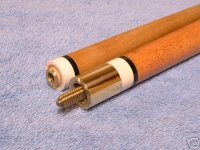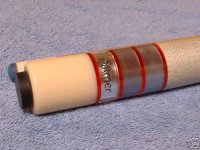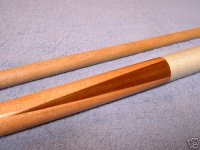Recently acquired this Palmer and was hoping to get an idea of what it is worth. Cue is really nice, original finish, rewrapped, new butt cap (would like to find an original one for it. The cue is straight and hits like a sledge hammer. The shaft may have a very slight wobble but it is so slight that I cannot really tell for sure. It is 19.3 oz, 12.9 mm tip. Bought this on Ebay.
Palmer B Model 2nd Catalog Cue Estimate
- Thread starter smonty46
- Start date
smonty46 said:Recently acquired this Palmer and was hoping to get an idea of what it is worth. Cue is really nice, original finish, rewrapped, new butt cap (would like to find an original one for it. The cue is straight and hits like a sledge hammer. The shaft may have a very slight wobble but it is so slight that I cannot really tell for sure. It is 19.3 oz, 12.9 mm tip. Bought this on Ebay.
This Model "B" Palmer in excellent refinished condition (which is what yours looks like) is worth about $600 - $700 with one shaft (they only came with one shaft) assuming the cue is relatively straight. You can buy one for less, but in this condition $600 to $700 is a fair price because most will be pretty banged up and in need of several hundred dollars of repairs.
Your cue is a nice example of a "true" 2nd Catalog Model B, meaning is was built in the late 1960's to early 1970's judging by the joint. Some were made at later dates and have delrin buttcaps and a different joint. It probably did not originally come with the rubber bumper, however, a bumper is a good idea because a lot of the buttcaps are broken when left unprotected. The replacement buttcap you have there looks pretty close to the real deal to me.
This cue was built on a bar cue stock maybe converted from an old house cue or built on a nice quality house cue blank supplied by the Ivring Katz company in Brooklyn. The handle looks like "jatoba" wood, or "Brazilian Cherry", a nice stable straight grain wood used in house cues at the time. The forearm is straight grain maple - the best wood for this. The points are rarely even on these converted house cues. If your points are dead even, add 15% to 20% to the value.
Your cue came pretty much as it looks, with Cortland linen wrap (the wrap job looks almost exactly like the original linen) and a Champion tip similar to a Le Pro (Palmer owned the trademark to these French leather tips).
The model "B" was the most popular window cue ever made. There were 6,000 produced in a 5 year period, very few of which are identical if you can believe it. They used different woods and different colors. Because they were an inexpensive cue, they were rarely personalized. The wholesale price was $35 and the retail about $75 at the time. I would estimate only 10% - 15%of these cues have survived because it was less expensive to buy a new cue than get it repaired. They were simply thrown out when broken.
This is a great cue to add to any collection if you want a classic Palmer window cue. They are still plentiful and affordable. Because of this, the prices are relatively low and new examples surface all the time. I have a number of them myself, no two of which are alike.
By the way, these old converted house cues play as good as modern cues. The balance on the old Palmers is pretty similar to todays cues, although they might be an ounce or so heavier.
Chris
Last edited:
There's a Model B on ebay right now but with black rings instead of red. May be the pictures but the points look like a lighter wood.
Hey Chris, just how different do they get? Are you talking special orders or did Palmer just use what they had in the shop at the time when making them as far as butt wood and points, etc?
Hey Chris, just how different do they get? Are you talking special orders or did Palmer just use what they had in the shop at the time when making them as far as butt wood and points, etc?
Jeff said:There's a Model B on ebay right now but with black rings instead of red. May be the pictures but the points look like a lighter wood.
Hey Chris, just how different do they get? Are you talking special orders or did Palmer just use what they had in the shop at the time when making them as far as butt wood and points, etc?
Here's how Palmer did it. They went to bars and pool rooms in Jersey and New York city and they cleaned out the excess old Brunswicks and Valley's - bought them used for a few bucks. They cut them, turned them, installed the joint and in most cases salvaged the shaft as well. They would rough out 300 cues at a time and finish them as the orders came in.
I think one of the reasons why these conversion cues play so good is because the shaft and butt were originally one piece of wood up to the handle in many cases - it may not sound like a big deal but the consistency of wood density makes for "good vibrations" and balance through the cue.
Many of these bar cues were 20 years old when they were converted, so you get every imaginable point set-up. Also, they tend to stay pretty straight because they were seasoned and didn't warp.
They also used about 20 or so different combinations of butt ring colors. Off the top of my head, red, gold, silver, black, navy blue, baby blue, green, and white. Then there were the wraps. Two tone Dacron was popular in a variety of colors.
When the orders came in, they would finish the cue to weight and length, wrap it to order, install the appropriate ferrule (screw on or fixed) and
As you know, I have a lot of Palmer's including duplicate models. I really can't say that I have any two alike.
Chris
Last edited:
THANKS! I like this board!!!!
Thanks for all the info. Now I know a lot more about these old Palmers. I was offered $800 for the cue yesterday but I think I will have a shaft made for it and keep it for a while. I bought it coz it was my weight and in such great condition. It is a really nice cue. Thanks Chris! And yes, that is the auction for the cue. Ernie
Thanks for all the info. Now I know a lot more about these old Palmers. I was offered $800 for the cue yesterday but I think I will have a shaft made for it and keep it for a while. I bought it coz it was my weight and in such great condition. It is a really nice cue. Thanks Chris! And yes, that is the auction for the cue. Ernie



